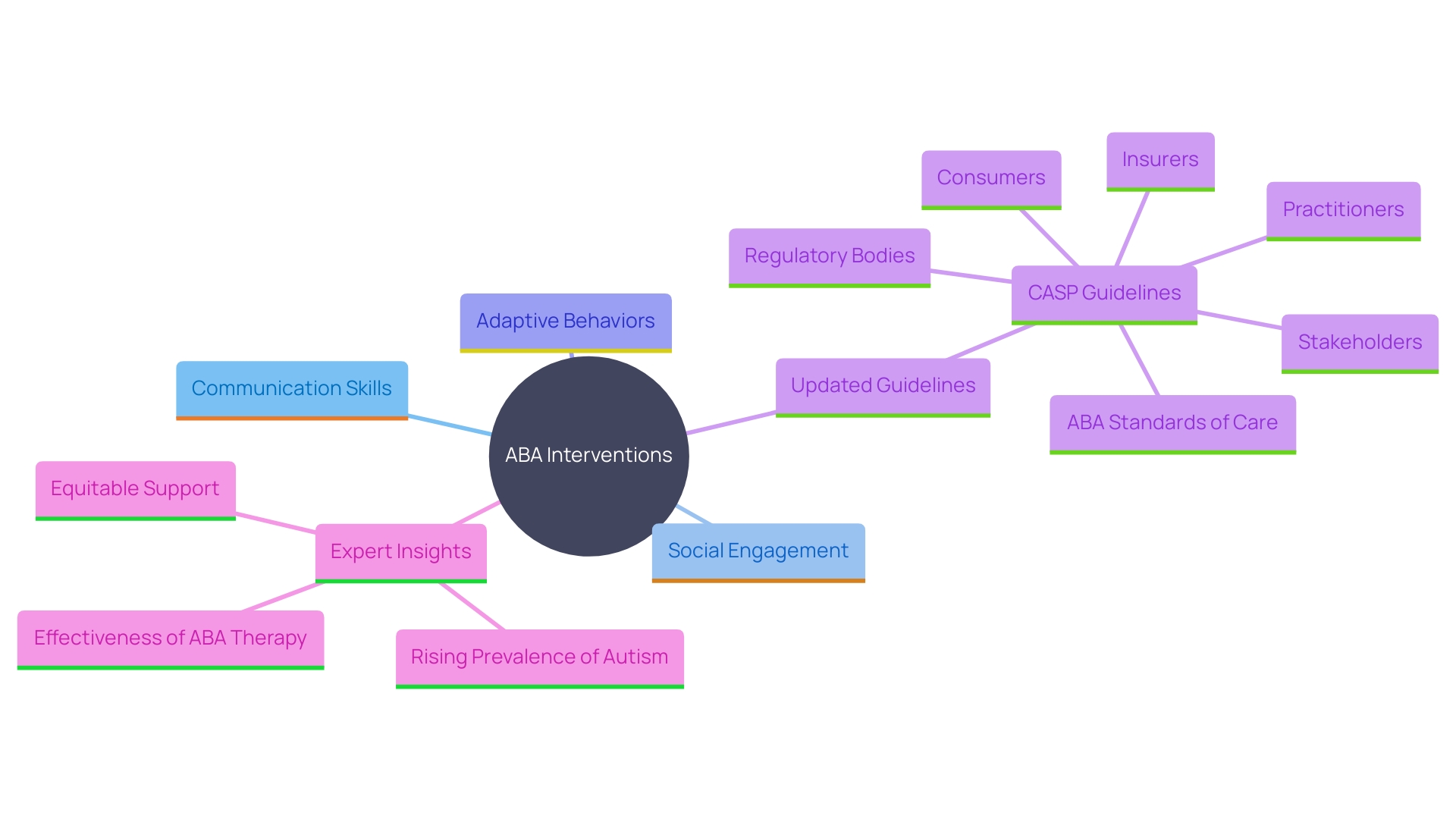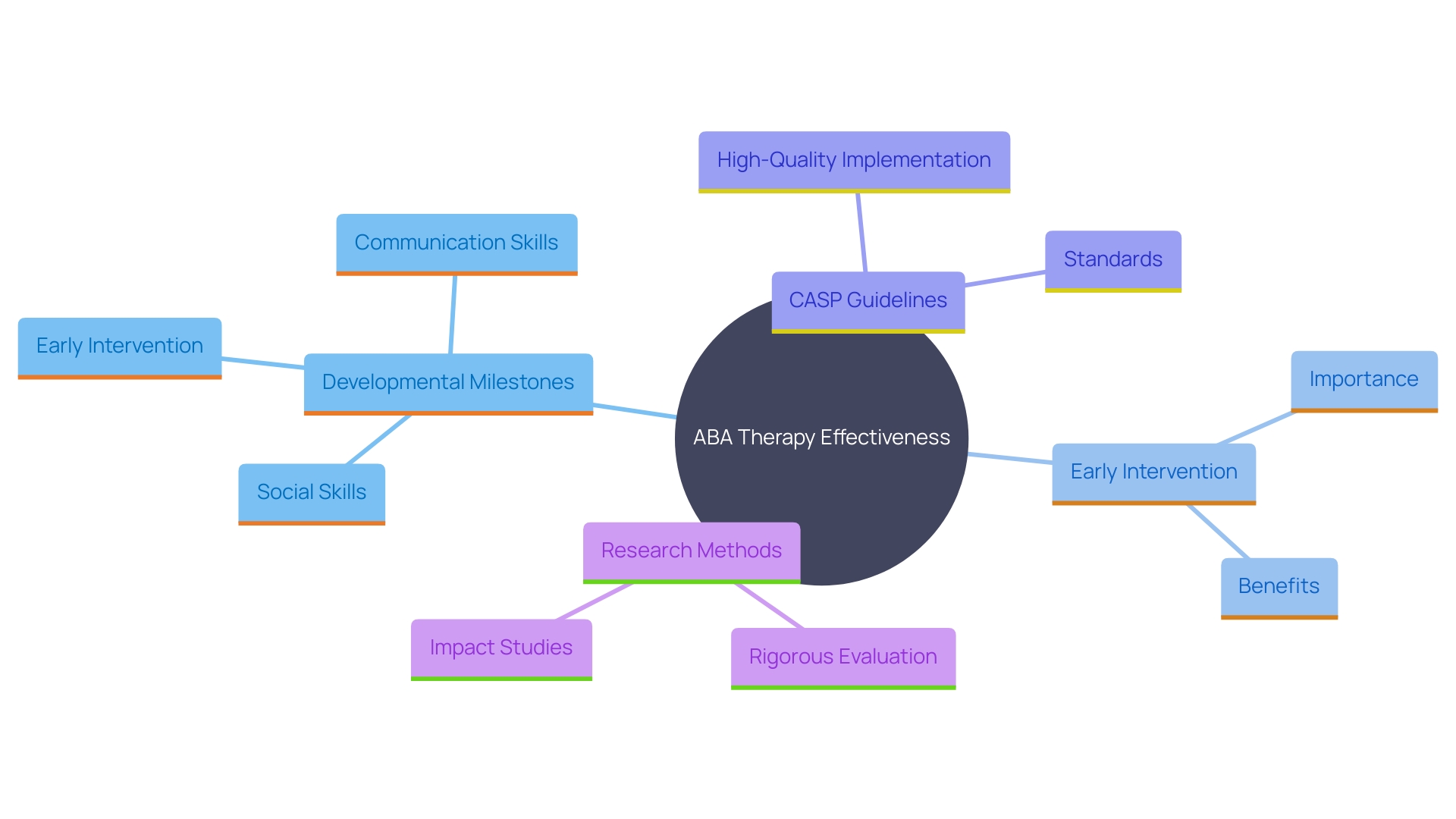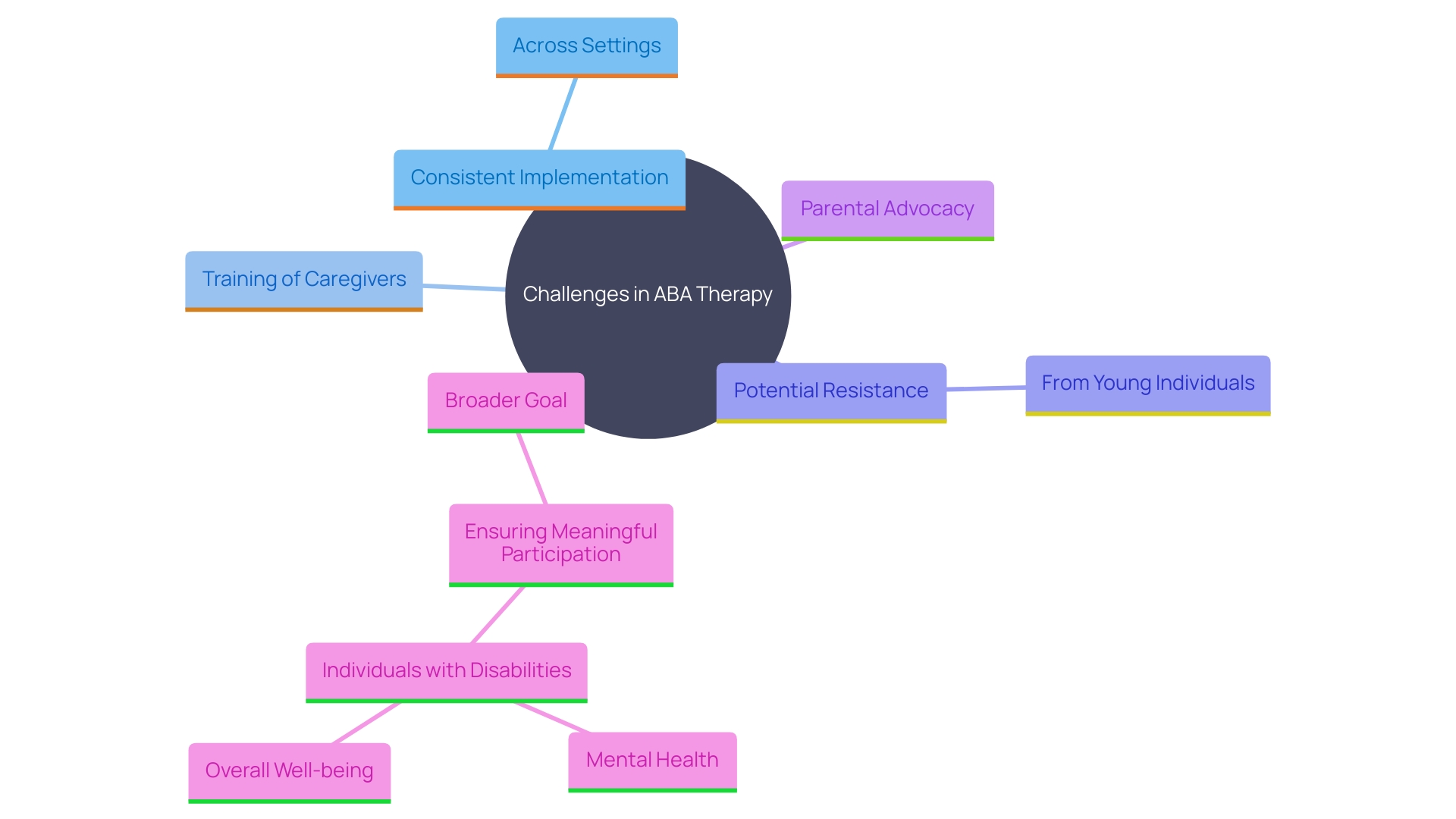Introduction
Applied Behavior Analysis (ABA) is a cornerstone in the realm of autism intervention, renowned for its scientific approach to understanding and modifying behavior. By leveraging principles of behaviorism, ABA aims to enhance positive behaviors while curtailing undesired ones, ultimately improving the quality of life for individuals with autism. This article delves into the core principles and methodologies of ABA, highlighting its benefits, effectiveness, and real-world applications through case studies.
It also addresses the challenges faced in ABA implementation and underscores the importance of high-quality, consistent practice. With insights from experts and updated guidelines from the Council of Autism Service Providers (CASP), the article equips parents and caregivers with the knowledge and resources to advocate effectively for their children, ensuring they receive the support they need to thrive in all facets of life.
Understanding ABA: Principles and Methods
Applied Behavior Analysis (ABA) is a scientific approach focused on understanding and altering behavior to improve quality of life, particularly for individuals with autism. By applying behaviorism principles, ABA encourages positive behaviors and reduces undesired ones. Key techniques like reinforcement, prompting, and data collection are central to personalizing strategies for each individual's unique needs. Emphasizing observable behavior and its interaction with the environment, ABA remains a practical and effective intervention strategy.
Dr. David (Dan) R. Offord, a renowned psychiatrist for young people, emphasized the importance of fair opportunities for all individuals, including those with disabilities. This philosophy aligns with ABA's goal of supporting youngsters with developmental differences to actively participate in school, home, and community life, thereby promoting mental health and equity. The Council of Autism Service Providers (CASP) recently updated the ABA Practice Guidelines, underscoring the importance of high-quality implementation. Lorri Unumb, CEO of CASP, noted, 'ABA is a highly effective treatment for the condition.'. But it has to be correctly implemented at the highest quality. These guidelines are key to achieving that.' Ensuring that caregivers have the necessary resources is crucial for fostering their offspring's development and well-being.
Benefits of ABA Interventions for Autism
ABA interventions offer considerable advantages for individuals with autism spectrum condition (ASC), improving their communication abilities, social engagements, and adaptive behaviors. By targeting specific skills and breaking them down into manageable steps, ABA facilitates the achievement of meaningful milestones. Parents often observe notable improvements in their offspring's ability to engage with others, follow instructions, and manage daily routines, ultimately enhancing the overall quality of life.
For instance, the Council of Autism Service Providers (CASP) has recently updated the ABA Practice Guidelines to ensure the highest standards of care. Lorri Unumb, CEO of CASP, emphasizes the importance of proper implementation, stating, "ABA is a highly effective treatment for those on the autism spectrum.". But it has to be correctly implemented at the highest quality.” These guidelines are crucial for maintaining the effectiveness of ABA therapy.
Furthermore, Dr. David (Dan) R. Offord, a renowned psychiatrist specializing in youth, highlighted the importance of fair and supportive environments for children with disabilities. He stated, “Growing up in Canada is like a race. "I do not mind if my offspring are in a competition as long as the competition is equitable. Ensuring that young individuals with disabilities, including those on the spectrum, have access to resources and support is essential for their mental health and overall well-being.".
The rising occurrence of this condition, now impacting 1 in 36 people, highlights the necessity for efficient strategies such as ABA. Dr. Jan Blacher, a research professor at UC Riverside, notes that the medical community's evolving understanding of autism has led to improved diagnostic criteria and more customized interventions, benefiting youngsters across the spectrum.
In summary, ABA therapy's structured approach and evidence-based techniques play a vital role in supporting individuals with ASD. By nurturing essential skills and offering a fair and supportive atmosphere, ABA assists young individuals in achieving their full potential and engaging meaningfully in their communities.

Case Study Examples: Implementing ABA Interventions
A compelling case study involved a 6-year-old boy diagnosed with Autism Spectrum Disorder (ASD) who had significant challenges with verbal communication and social interaction. An Applied Behavior Analysis (ABA) intervention plan was carefully crafted to address these issues, utilizing visual aids and structured play to enhance his communication skills. Over a span of six months, the boy's progress was remarkable. He began engaging in more verbal interactions and showed considerable improvement in his social skills during playdates. The active involvement of his parents, who reinforced the learned behaviors at home, played a crucial role in his success. This case highlights the significance of offering well-supported involvement for youngsters with disabilities, as stressed by renowned psychiatrist Dr. David (Dan) R. Offord. Ensuring that caregivers have the necessary resources to support their offspring's development is vital for achieving mental health and equity, making the race fair for all youth, including those with disabilities.
Effectiveness of ABA Interventions: Research Findings
Thorough studies consistently highlight the effectiveness of ABA therapy for youngsters with developmental disorders. Research shows that individuals who experience intensive ABA therapies frequently reach notable developmental milestones in contrast to peers who do not receive such support. A notable meta-analysis highlighted that early and intensive ABA therapy leads to remarkable gains in language acquisition and adaptive functioning. This early assistance is essential for ensuring that young individuals with developmental differences can flourish.
The importance of ABA is further emphasized by new guidelines from the Council of Autism Service Providers (CASP), which aim to standardize high-quality implementation. According to Lorri Unumb, CEO of CASP, 'ABA is a highly effective treatment for individuals on the autism spectrum.'. But it has to be correctly implemented at the highest quality. These guidelines are key to achieving that.”
One poignant perspective comes from Dr. David (Dan) R. Offord, who likened growing up to a race, emphasizing that the race should be fair. Ensuring that young individuals with disabilities, including those with autism, receive the support they need is fundamental to their well-being and equitable participation in society. This includes providing parents with the resources necessary to support their offspring’s development effectively.
Recent changes in study methods also contribute to understanding the effectiveness of various strategies. Randomized controlled trials, for instance, are now more frequently used to provide robust evidence. This changing environment of research methods guarantees that approaches like ABA are consistently assessed and improved to provide the best results for young individuals and their families.

Challenges and Considerations in ABA Implementation
While ABA therapy is effective, it comes with certain challenges. Consistent implementation across various settings, such as home and school, is crucial. However, this can be difficult as not all caregivers may be trained in ABA techniques. Furthermore, young individuals might resist certain interventions, necessitating continuous assessment and strategy modification. Comprehending these challenges enables parents to advocate for their offspring's needs effectively and create a supportive learning environment. Dr. David (Dan) R. Offord, a renowned psychiatrist specializing in youth, emphasized the importance of ensuring individuals with disabilities, including those with autism, participate meaningfully in all areas of their lives. This participation is essential for their mental health and equity. Parents need the resources to support their child's development and well-being, reducing chronic stress and recognizing the unique needs and strengths their children bring to the community.

Conclusion
Applied Behavior Analysis (ABA) emerges as a transformative approach for children with autism, providing a structured framework to enhance their communication, social skills, and overall quality of life. By focusing on observable behavior and the interactions within their environment, ABA employs scientifically backed methods that empower children to achieve meaningful milestones. The recent updates from the Council of Autism Service Providers (CASP) further emphasize the necessity of high-quality implementation, ensuring that caregivers are equipped with the right resources to support their children effectively.
The benefits of ABA are evident through numerous case studies and research findings, illustrating significant developmental gains in children who receive this intervention. As highlighted, early and intensive ABA therapy facilitates critical improvements in language acquisition and adaptive functioning, enabling children to thrive in their daily lives. This structured approach not only fosters essential skills but also promotes an equitable environment where all children, regardless of their abilities, can participate fully in society.
Despite its effectiveness, challenges in ABA implementation exist, necessitating consistent practice across various settings. Parents play a pivotal role in advocating for their children's needs and ensuring that the interventions are tailored to their unique circumstances. By understanding these challenges and seeking out necessary resources, caregivers can create a supportive environment that nurtures their children's development, ultimately paving the way for a brighter future.
The journey may be complex, but with the right tools and unwavering support, children with autism can reach their full potential and lead fulfilling lives.




